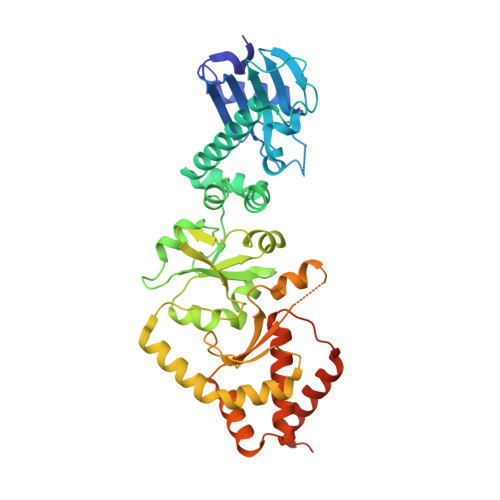Structural basis of the key residue W320 responsible for Hsp90 conformational change.
Peng, S., Matts, R.L., Deng, J.(2022) J Biomol Struct Dyn : 1-11
- PubMed: 36373326
- DOI: https://doi.org/10.1080/07391102.2022.2146197
- Primary Citation of Related Structures:
7RXZ, 7RY0 - PubMed Abstract:
The 90-kDa heat shock protein (Hsp90) is a homodimeric molecular chaperone with ATPase activity, which has become an intensely studied target for the development of drugs for the treatment of cancer, neurodegenerative and infectious diseases. The equilibrium between Hsp90 dimers and oligomers is important for modulating its function. In the absence of ATP, the passive chaperone activity of Hsp90 dimers and oligomers has been shown to stabilize client proteins as a holdase, which enhances substrate binding and prevents irreversible aggregation and precipitation of the substrate proteins. In the presence of ATP and its associated cochaperones, Hsp90 homodimers act as foldases with the binding and hydrolysis of ATP driving conformational changes that mediate client folding. Crystal structures of both wild type and W320A mutant Hsp90αMC (middle/C-terminal domain) have been determined, which displayed a preference for hexameric and dimeric states, respectively. Structural analysis showed that W320 is a key residue for Hsp90 oligomerization by forming intermolecular interactions at the Hsp90 hexameric interface through cation-π interactions with R367. W320A substitution results in the formation of a more open conformation of Hsp90, which has not previously been reported, and the induction of a conformational change in the catalytic loop. The structures provide new insights into the mechanism by which W320 functions as a key switch for conformational changes in Hsp90 self-oligomerization, and binding cochaperones and client proteins.Communicated by Ramaswamy H. Sarma.
- Department of Biochemistry and Molecular Biology, Oklahoma State University, Stillwater, OK, USA.
Organizational Affiliation:


















